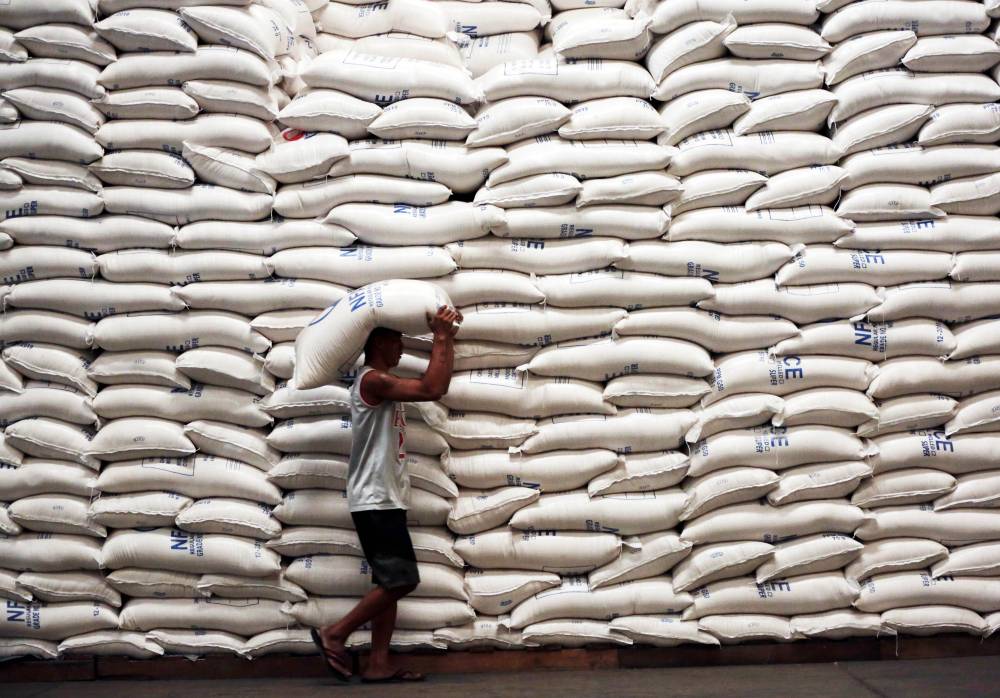
A worker stacks rice at a warehouse of the National Food Authority (NFA) in Visayas Avenue in Quezon City in this file photo taken on January 15, 2020. House lawmakers say rice prices may go down due to cut in rice tariff. INQUIRER PHOTO / GRIG C. MONTEGRANDE
MANILA, Philippines — Rice prices may go down by P5 to P6 per kilogram between June or July due to President Ferdinand Marcos Jr.’s approval of the reduced tariff rates for rice, House of Representatives lawmakers said on Thursday.
During a press briefing after meeting stakeholders from the rice industry, House committee on agriculture chairperson and Quezon 1st District Rep. Wilfrido Mark Enverga said that the number was based on the Philippine Statistics Authority (PSA) computation.
“As far as PSA has reported out, it’s going to be less by P5 to P6 per kilo(gram). P5 to P6 per kilo,” Enverga said when he and Speaker Ferdinand Martin Romualdez were asked about the possible impact of the tariff cut on market prices.
Deputy Majority Leader and ACT-CIS party-list Rep. Erwin Tulfo said the number could be lower depending on the peso-dollar exchange rate — with a stronger peso possible decreasing rice prices even more.
“Pero that’s depending on the, that P5 to P6 at the current exchange rate po ‘yon P58 po (per $1), if the dollar goes down, mas mataas pa doon, so depending on the dictate of the exchange rate,” he noted.
(But that’s still depending on the — that P5 to P6 at the current exchange rate po ‘yon P58 (per $1), if the dollar goes down, then the rice price cut will be higher, so it is dependent on the dictate of the exchange rate,” he noted.
Romualdez meanwhile clarified that the expected rice price reduction is not only confined to rice sold in Kadiwa stores, as the tariff cuts will have a nationwide effect.
According to Romualdez, they have also talked to importers and market retailers about the possibility of selling Kadiwa products in major grocery chains — with one major player already agreeing to this scheme.
“That’s still in a limited market so to speak, because Kadiwa really was intended to target the marginalized sector and then provide very basic na goods and commodities. However as I said, with the whole-of-nation approach, stores will be part of the program because we’re talking to the importers, to the traders, we’re talking of course to the local producers,” Romualdez said.
“But even, I’ll be specific, we talked to a grocery chain, they are also ready to carry Kadiwa rice in their stores […] for so long as stocks and inventories permit, they will carry that,” he added. “They’re also volunteering, and subject to the policies of the Kadiwa, they even want to support by providing an outlet within their stores to provide the Kadiwa stores with other basic commodities in the stores that are not yet readily available, at 10 to 15 percent discount.”
Last Tuesday, Socio-economic and Development Secretary Arsenio Balisacan said that the President had already approved the reduction in the tariffs on rice, coal, and other basic commodities.
Balisacan said the President, who chairs the National Economic and Development Authority board, approved the new Comprehensive Tariff Program for 2024-2028, which calibrates tariff rates until 2028.
READ: Marcos approves cut in rice tariff to 15%
However, several observers questioned the deduction in the tariff rates, noting that this move would only encourage more imported rice to come into the country.
Romualdez and Enverga countered this, saying earlier that the rice tariff reduction is only aimed at absorbing the impact of high rice prices in the world market.
Romualdez also reiterated that support to the farmers would continue, as the provision of assistance through the Rice Competitiveness Enhancement Fund (RCEF) would continue.
Tariffs required of imported rice are directed into the RCEF, as required by Republic Act No. 11203 or the Rice Tariffication Law (RTL).
On Wednesday, Romualdez and other lawmakers said they believe the rice tariff rate reductions would result into a lower rice price at the local market. However, the Speaker still maintained that there is still a need for long-term solutions — particularly amendments to the RTL.
Last May 21, the House approved House Bill No. 10381, a proposal seeking to amend the RTL, to restore some of the National Food Authority (NFA) functions.
READ: House amendments to rice tariff law approved on 3rd reading
If signed into law, NFA will have the “authority to oversee and ensure compliance with all pertinent standards and regulations, leveraging its established expertise and nationwide network to uphold the national interest, in rice buffer stocking and food security,” by placing a new Section 5 in R.A. No. 8178.